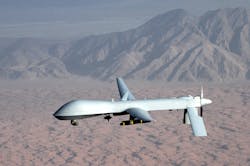Drones: Applications, Components, and Market View
Since their debut, a variety of drone types have been used in applications ranging from weather monitoring to warfare. In the process, they had to overcome some monumental design challenges—just as new drones must to meet today’s advancing requirements. Currently, the biggest design issues facing drone development include incompatibility amongst systems and subsystems, lack of standards, and cost, weight, endurance, and altitude factors. This information is just one aspect of the data provided in the “2013 Components for Unmanned Vehicles – Marketing Guide and Directory” from Information Gatekeepers, which is a companion to the firm’s recently published “UAV Marketing Directory.”
The guide notes that microwave and RF technologies are increasingly in demand by drones. Examples include the following: sensors for side-looking and phased-array radars; lower-cost microwave components; lower-power drain components; GPS receivers; radar altimeters; seek and avoid sensors; satellite-receiver antennas; and low-radar-detection materials and signatures.
The report also looks beyond aerial systems by including information on ground, maritime, submarine, and satellite unmanned systems. All common systems are mentioned as well as more unusual types like solar-powered and laser-tethered UAVs. The most popular UAVs to date have been the smaller systems used by the US Army for reconnaissance. However, the system with the biggest dollar volume has been the Predator. Used by the US Air Force and the CIA since 1995, the Predator consists of four aircraft systems with sensors, a ground-control station, and a primary satellite-link communication suite.
The directory features 1000 companies, which are primarily component, materials, and subsystems equipment suppliers. Those suppliers are rounded out by companies providing services, consulting, training, and more. Among component supplier companies, United Technologies (UTC) and DRS Technologies have become key players in the drone market.
Applications Old And New
In terms of application progression, drone development has been mainly driven by military applications (providing reconnaissance for all branches). The next major market is agriculture, followed by government, law enforcement (homeland security), maritime, oil and pipeline, broadcasting, and real estate. Although the Sequester and budget cuts have created challenges for the defense industry, the UAV market has not been affected substantially. According to the author of the report, Dr. Paul Polishuk, “There may be a shifting in emphasis, but UAVs represent a national policy to keep armed forces out of harm’s way.”
More information, including purchase details, on the report can found here.
About the Author
Iliza Sokol
Associate Digital Editor
Iliza joined the Penton Media group in 2013 after graduating from the Fashion Institute of Technology with a BS in Advertising and Marketing Communications. Prior to joining the staff, she worked at NYLON Magazine and a ghostwriting firm based in New York.
